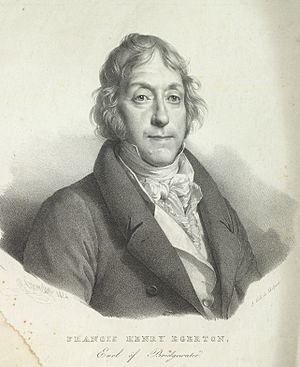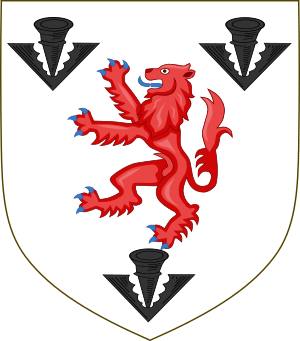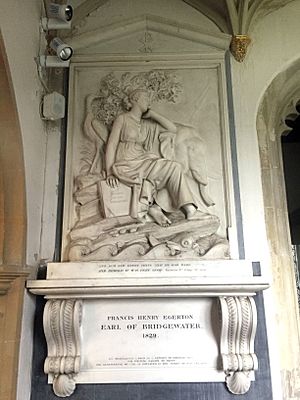Francis Henry Egerton, 8th Earl of Bridgewater facts for kids
Francis Henry Egerton, 8th Earl of Bridgewater, was a British nobleman known for his unique personality and his support of natural theology. This is a way of understanding God through nature and reason. He was also a Church of England clergyman.
Francis Egerton was a scholar, a keen naturalist (someone who studies nature), and an antiquarian (someone who studies old things). He inherited his title, the Earl of Bridgewater, in 1823 from his brother, John. He spent the last years of his life living in Paris, France. When he passed away in 1829, his earldom came to an end because he had no children to inherit it.
Contents
Early Life and Education
Francis Henry Egerton was born in London in 1756. His father was John Egerton, who was the Bishop of Durham. His mother was Anne Sophia Grey.
He went to school at Eton College, a famous boarding school. After that, he studied at Christ Church, Oxford University, where he earned his first degree in 1776. In 1780, he became a fellow at All Souls College, Oxford. A fellow is like a senior member or researcher at a college. In 1781, he became a Fellow of the Royal Society, which is a very old and respected group for scientists.
Life and Habits
Francis Egerton was known for his very unusual habits. For example, in his house in Paris, he kept many dogs and cats. He would dress them up in fancy clothes, like ladies and gentlemen! He even took them with him in his carriage.
He also kept birds like partridges and pigeons in his garden. Their wings were clipped, so they couldn't fly away. This allowed him to shoot them, even though his eyesight wasn't very good.
He never married, and because of this, his title as Earl of Bridgewater ended when he died. He was buried in a place called Little Gaddesden in Hertfordshire, England.
Family Home and Chapel
Centuries before Francis Egerton, in the early 1600s, another family member named Thomas Egerton bought a very large house called Ashridge House. This house was one of the biggest country homes in England. It had been owned by Queen Elizabeth I, who got it after the monasteries were closed down in 1539.
Ashridge House was the main home for the Egerton family for many years, until the 1800s. The Egerton family also had their own special chapel, called the Bridgewater Chapel. It was located in the church at Little Gaddesden. Many members of the Egerton family, including Dukes and Earls of Bridgewater, are buried there.
Contributions to Arts and Science
Francis Egerton was very interested in learning and discovery. He became a Fellow of the Royal Society (F.R.S.) in 1781. This society promotes science and is one of the oldest scientific organizations in the world. He also became a Fellow of the Society of Antiquaries of London (F.S.A.) in 1791. This group focuses on studying history and old objects.
In 1812, he wrote a book called "Description du Plan Incliné Souterrain." This book was about the underground canals in the Worsley Navigable Levels. These were part of the coal mines in Worsley, which belonged to the Bridgewater family estate.
Death and Legacy
When Francis Egerton died in February 1829, his titles ended. However, he left behind a very important legacy through his will.
He gave a valuable collection of old writings, known as the Egerton Manuscripts, to the British Museum. These manuscripts included 67 important documents about French and Italian literature. He also left £12,000 to start the Egerton Fund. This fund allowed the British Museum to buy even more manuscripts. Since then, over 3,800 manuscripts have been bought using this fund.
He also left £8,000 to the president of the Royal Society. This money was meant to pay authors who would write and publish books about "The Power, Wisdom and Goodness of God, as manifested in the Creation." This led to a series of eight books known as the Bridgewater Treatises, which were published between 1833 and 1836.
See also
- Egerton Collection




